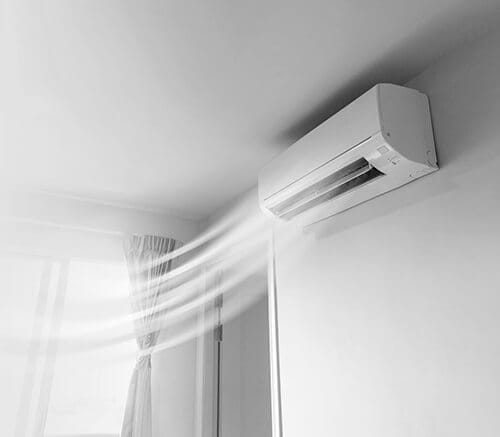
If you have a home that requires a new heating and cooling system, you may be considering central air conditioning. Perhaps you have added an addition to your home, and you’re wondering how to cool and heat the new room.
The traditional method of cooling every room in a house requires ductwork that reaches each separate location. While traditional, this may not be practical in every residence. Retro-fitting a home with whole-house ductwork may not be feasible due to space restraints or the layout of the house. Homes that were originally built with non-ducted heating systems, such as hydronic, radiant heat, or space heater systems may not be able to be fitted with ducts retroactively.
One popular alternative is known as a mini-split system or ductless mini-splits.
What is a Ductless Mini-Split?
In simple terms, a ductless mini-split system is a type of heating and cooling system used in homes and buildings. Unlike traditional HVAC systems that rely on ductwork to distribute air, a ductless mini-split system does not require ducts.
Instead, each room gets its own evaporator unit and fan for heating and cooling. Do you like to keep your bedroom a little cooler than the other rooms of your house? If so, then mini-split heating and cooling may be the solution for you. It allows you to set up every room as a separate zone.
Examples of Mini-Split Systems
Other examples of mini-split heating and cooling include duo-zone and tri-zone mini-splits. Duo-zone mini-splits divide the house into two zones, each with its own temperature controls. Similarly, tri-zone mini-splits divide the house into three separate temperature-controlled zones.
The number of mini-splits you decide on for your home should consider the design of your house, the comfort level you wish to achieve in each zone, installation costs, and the costs of the materials you’ll need. A heating and cooling technician can help you determine your home’s needs.
In addition to the indoor part of the mini-split system, each mini-split heating and cooling system also includes an outdoor component called the compressor or condenser. The outdoor unit houses the system’s power supply, tubing, and condensation drain. Lines that connect each indoor unit to the outdoor unit are small and can typically be hidden for aesthetic considerations. One of these will accommodate several interior units.
Now let’s talk about what Central Air is:
What is Central Air?
In simple terms, central air refers to a type of heating, ventilation, and air conditioning (HVAC) system that uses a centralized unit to cool and heat an entire building, such as a house or an office.
Unlike standalone air conditioners or heaters that are placed in individual rooms, a central air system typically has a central unit, often located outside the building, that cools or heats air. This treated air is then distributed throughout the building through a system of ducts and vents.
Advantages of Mini-Splits Over Central Air
Mini-split heating and cooling systems have many advantages when compared to traditional central air systems. Some of these advantages include the following.
1. Better Temperature Control in Each Room
With an individual fan and evaporator unit in each room, you have better control over how warm or cool to keep each individual zone. A home that might have hot or cold spots with traditional central air conditioning can be adjusted with mini-splits. Since the temperature can be controlled in each room instead of from one centralized location that affects all the rooms, this system can also head off arguments over which member of the household gets to control the thermostat.
Some rooms are inadequately insulated and easily affected by excessive heat or cold outdoors. This is often true of garages, apartments converted from above-garage space, and three-season rooms. In these areas, a mini-split system will act like a heat pump, making it more efficient to heat and cool these areas effectively.
2. Save Energy
Do you have a lesser-used area of your home, maybe a spare bedroom? If temperature control in one zone isn’t as important to you because no one in your household is using that space, you can keep the level of heating or cooling low in that zone alone to save energy. You can even turn off the heating or cooling in one or more rooms to save energy.
3. Save Money
By heating and cooling only the parts of your home that you occupy, you’ll use less energy and save on energy costs. Some mini-split units have an automatic energy-saving mode that allows you the option of having the unit automatically switch off when no one’s in the room.
Check with your local utility company when considering installing a mini-split system in your home. In some locations, you may be eligible for a utility refund or credit when you install a more energy-efficient heating and cooling system. Tax credits may also be available, again depending on your location.
4. Save Space
The in-room components of a mini-split system can be installed along the ceiling or the floor, saving wall space. No room needs to be taken up by ductwork, and only a three-inch hole needs to be drilled to connect to the outdoor component. Mini-splits take up significantly less room than traditional heating and cooling systems.
5. Quieter Operation
Mini-splits, in general, run more quietly than central heating and air conditioning systems. They don’t cycle off and on like central air conditioners do, but rather run at one consistent speed. Not only does this reduce noise, but it also helps keep the temperature of each room consistent.
6. Reduce Humidity and Indoor Air Pollution
When used in air conditioning mode, mini-splits help reduce the humidity in your home’s air. A bonus is that mini-split systems improve indoor air quality overall in your home. Ductwork must be cleaned on a regular basis to avoid ducts becoming a haven for dust, pet dander, mites, and other irritants. By using a ductless system, you’ll avoid these indoor air pollution problems.
7. Portability
A mini-split system is relatively easy to install in almost any home, and it can just as easily be removed and reassembled in another one. If you decide to move and take your mini-split system with you, this is not only possible, but also much more practical than attempting to remove and move a ducted system.
8. Greater Energy Efficiency
Mini-splits also help you control the energy efficiency of your heating and cooling system by allowing you to control the position of your unit. You can place a mini-split virtually anywhere within a room. Whereas, with a central air unit, you are limited in its placement. Furthermore, with a mini-split, you control the position of the heating and cooling vents, so air is not trapped behind a sofa. With central air units, many times ducted vents are blocked by furniture.
9. Lack of Ducts
Another way that mini-splits are more efficient than central air conditioning is their lack of ductwork. Ducts can lower efficiency when they have leaks or cracks that allow some of the air to escape before it reaches its destination. According to the U.S. Department of Energy, up to 30% of a cooling system’s efficiency may be lost to faulty ductwork.
Your Local Professionals
Overall, mini-split systems are much easier and quicker to install than traditional heating and air conditioning units. Additionally, by using a mini-split system, you can reap many benefits such as increased energy efficiency and saving money. When you consider adding a ductless mini-split system to your home, reach out to our experts at Polar Air & Heating, Inc.. Our professionals have years of experience, and they will certainly perform all the work to your satisfaction.
Whether you want to install a mini-split system or you need air conditioning or heating repair, maintenance, or replacement, our technicians can help. We also offer indoor air quality services, germicidal UV lighting, and more. Call Polar Air & Heating, Inc. today to schedule an appointment and get a quote.






















